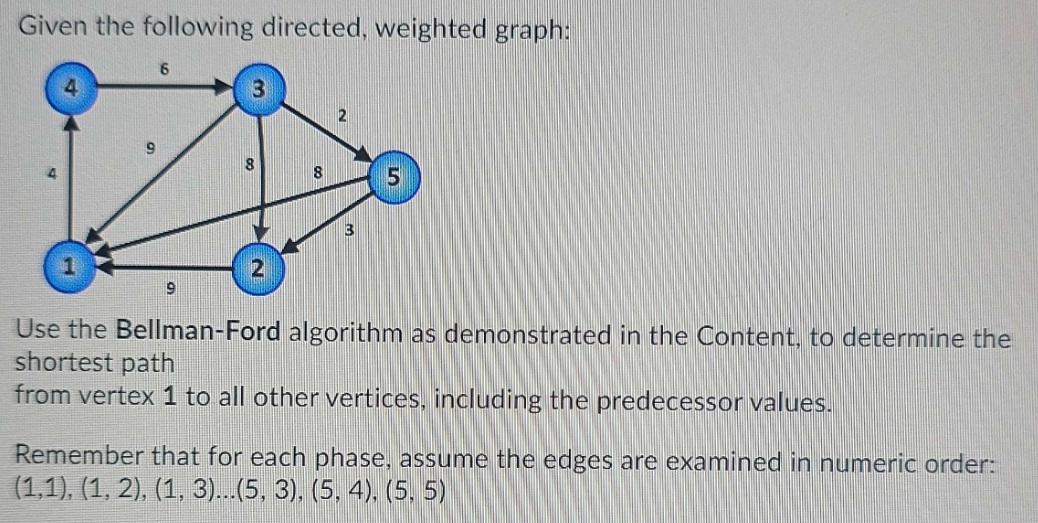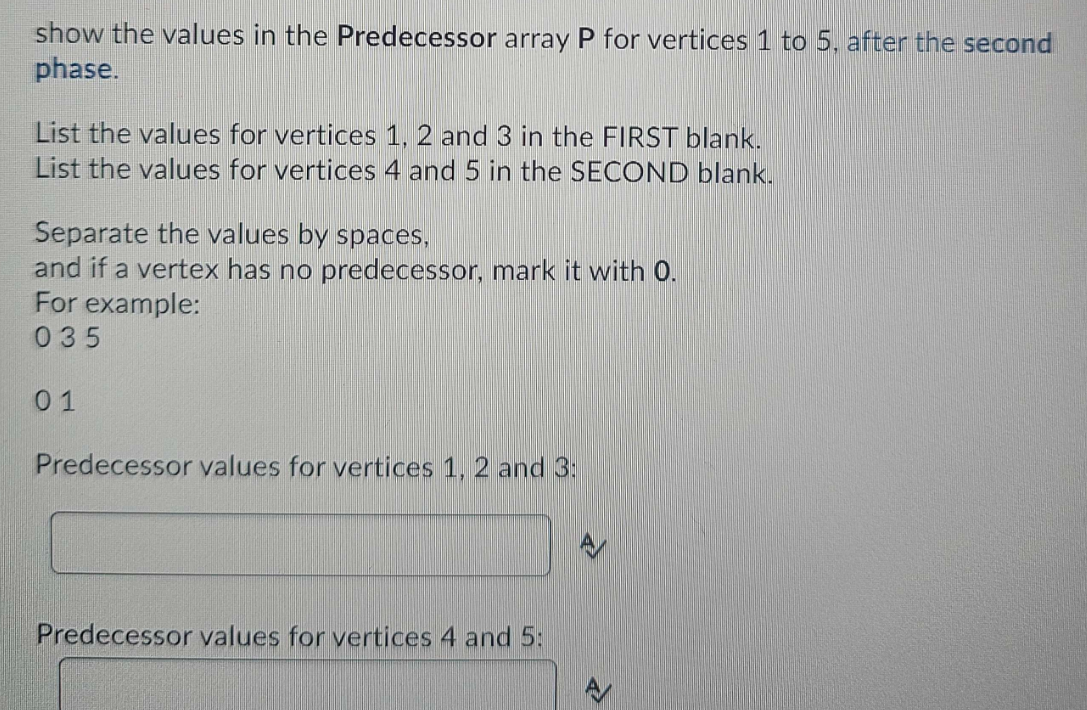Answer this two question: Predecessor value for vertices 1, 2 and 3: Predecessor value for vertices 4 and 5
Q: Write the pseudocode for Jarvis-march algorithm and trace it for the points provided in the diagram…
A: The Jarvis March algorithm, also known as the Gift Wrapping algorithm, is used to find the convex…
Q: Array = [10, 100, 10000, 1, 100000, 1000000, 100, 1000, 10000, 10000000, 1000000000, 100000000,…
A: Here is your solution - ( HERE NO SPECIFIC LANGUAGE IS MENTIONED SO I AM USNG JAVA )
Q: Dive deeper into thread scheduling algorithms. Explain how different scheduling algorithms (e.g.,…
A: Task management in operating systems involves the management and scheduling of processes and threads…
Q: How many nodes would there be in a PATRICIA trie representing the following 8-bit unsigned binary…
A: In the context of representing 8-bit unsigned binary numbers, the number of nodes in a PATRICIA tree…
Q: Factorize the binned variables for ‘UnsecLines', 'Age', 'MonthlyIncome', and 'N_OpenCredit'. Make…
A: The objective of the question is to factorize the binned variables for 'UnsecLines', 'Age',…
Q: PROBLEM 1 a. Depict full key functional dependencies, partial functional dependencies (if any), and…
A: The subject at hand revolves around the organization of student internships, employers, and…
Q: Hello, I really need help trying to figure out which bineary tree this could be and can you explain…
A: In this question we have to understand about the given trees and understand about the types of…
Q: - Find the maximum element of the array max(a, n) X total = 0 for i=1 to n total = total + a[i]…
A: Input: An integer array 'a[]' with 'n' elements.Output: The maximum element in the array.1.…
Q: Q.1 Use the breadth-first search algorithm to find a spanning tree for the connected graph (Start…
A: An approach for graph traversal called Breadth-First Search (BFS) is frequently used to locate a…
Q: What is the result of the query below? SELECT * FROM table1 WHERE val1 IN (SELECT vall FROM table1…
A: A SQL query is a high level English sentence used to work with a database which could be the…
Q: List the location name and location ID where the location ID is 1400, 1500, or 1800. Use INoperator.…
A: The objective of the question is to retrieve the location name and location ID from a database where…
Q: What would be the resulting Data Structure if the black nodes of a Red Black Tree would absorb it's…
A: The objective of the question is to understand the transformation of a Red-Black Tree when a…
Q: Array = [10, 100, 10000, 1, 100000, 1000000, 100, 1000, 10000, 10000000, 1000000000, 100000000,…
A: Merge sort is a divide-and-conquer algorithm that works by recursively dividing an array into…
Q: Primary Difference between stack and queue
A: The stack follows the Last In, First Out (LIFO) principle, which means that the last element added…
Q: 5.01-2. Dijkstra's Algorithm (1, part 2). Consider the network shown below, and Dijkstra's link-…
A: In this question we have to understand Dijkstra's link-state algorithm.It is a graph algorithm that…
Q: Consider the set of items S = {a, b, c, d, e, f, g, h}, where the items have the following (benefit,…
A: The task at hand is to maximize the total benefit while staying within a maximum weight constraint…
Q: For each of the algorithms uniquel and unique2, which solves the element uniqueness problem, perform…
A: The Element Uniqueness Problem is a classic problem in computer science. It asks whether all the…
Q: Apply the divide-and-conquer Karatsuba algorithm to multiply 1234 × 4321 (in decimal). Stop the…
A: The Karatsuba algorithm is a divide-and-conquer method for multiplying two numbers. It's a…
Q: 5. The state of a system at a particular time is shown in Table 1. Total resource unit of R1, R2, R3…
A: Banker's algorithm is a resource allocation and deadlock avoidance algorithm that tests whether the…
Q: DENSE-SUBGRAPH: Given a graph G and two integers m and n, does G have a set of m vertices with at…
A: The Dense-Subgraph problem falls within the realm of NP-complete problems, implying that it is a…
Q: By using the B-tree in Figure 3; Redraw the tree after deleting 22. Redraw the tree after deleting…
A: B-Tree is a self balancing search tree that is widely used for disk access. A B-tree of order m can…
Q: Give an algorithm in pseudo-code using depth-first algorithm for some task like finding if a graph…
A: When navigating or searching through data structures like graphs or trees, a depth-first algorithm…
Q: Answer the following with proper justification and plagiarism free numerical example/ appropriate…
A: In this question, we have to understand
Q: I have a binary file with 1000000 numbers in it called 1000000numbers.bin but i tried running it and…
A: If you are running a C++ program to read and process a binary file and the output is not displaying,…
Q: 5.04-4. Bellman Ford Algorithm - a change in DV (1, part 4). Consider the network below, and suppose…
A: Bellman Ford Algorithm is a distance-vector routing algorithm that works by distributing the…
Q: Below is the IntTree class. We are in the middle of implementing a new recursive method called…
A: To correctly implement the leafCount method, we need to handle the base cases and the recursive…
Q: For the following RedBlackTree how would you build a Search Method utilizing strings in Java? I try…
A: The provided Java code implements a Red-Black Tree (RBT) data structure, a self-balancing binary…
Q: What is heap? Explain in detail with example
A: In the intricate world of data structures, one particular structure stands out for its efficiency…
Q: 2. Use the master theorem to find the following in O-notation: 1. T(n) = 4T(n/2) + n 2. T(n) =…
A: Dear Student, you have uploaded a question that has multiple sub-parts in it. As per our guidelines,…
Q: 8. What are the differences between Stack and Queue data structures.
A: In the field of computer science, data structures play a crucial role in efficiently storing,…
Q: 3 4 5 6 7 17 3 12 S 15 6 2 9 S.top=6 Assuming we have the stack S as depicted above, with its top…
A: Stack is a data structure that is based on Last in First Out (LIFO). Any element that comes at last…
Q: Consider the below code. #include using namespace std; class Count { public: int count; };…
A: In the increment function, we are passing myCount by value, which means we're working with a copy of…
Q: Using the same graph as in the previous question, list the vertices in the order that they will be…
A: Breadth First Search Traversal is a graph traversal technique which uses queue data structure. From…
Q: 8. Explain the concept of Dynamic Programming and its application in solving optimization problems.
A: Complex optimization problems can be methodically solved using dynamic programming (DP), which…
Q: Simplify the following, using Θ-notation: 13n^2 +n/n^2
A: Theta notation Θ is a mathematical way to describe the asymptotic behavior of an algorithm or…
Q: 2. Please work on a piece of paper. Use quick sort to sort the following array {6, 2, 5, 9, 4, 2, 3,…
A: Using quick sort to sort the following array (6, 2, 5, 9, 4, 2, 3, 7, 1, 8, 5). finding Is quick…
Q: 6. T(n) = 5T(n/2) + n²
A: Big O is a mathematical notation that describes the upper bound on growth rate of time complexity in…
Q: Explain the concept of Object-Oriented Programming (OOP) and provide an example of how inheritance…
A: Object-Oriented Programming (OOP) is a fundamental programming paradigm that organizes code into…
Q: For the AVL Tree what values could you insert to cause a right-left imbalance and at which node does…
A: AVL tree is a type of self balanced binary tree which contains balancing factor for each node as…
Q: Solve using the Prims algorithm. Show all steps, minimum spanning tree, and final cost. Start from…
A: Key characteristics of a spanning tree:Spanning: A spanning tree must contain all the vertices of…
Q: f lim n->oo (f(n))/(g(n)) = 0 then f(n) = ω( g(n) ) true false
A: In this question we have to understand the given statement and decide whether the given statement is…
Q: Consider the following undirected graph: His h If you traverse the graph using the Breath First…
A: It is the most common search strategy for traversing a tree or graph.This algorithm searches breadth…
Q: • Discuss stack data structure, insertion operation, deletion operation, and a real-world technical…
A: In this answer we are going to discuss about three data structure, their functions and examples.
Q: . Design an FSM over the alphabet (0, 1) that accepts strings that do NOT have 111 as a substring.…
A: 5. Design an FSM over the alphabet {0, 1} that accepts strings that do NOT have 111 as a substring.…
Q: We know that in "case 2" of the Master Theorem Method, where f(n)=Θ(n^log_b(a)) (assume suitable…
A: The Master Theorem is useful for algorithm analysis and design, especially for recurrence relations.…
Q: Java source code writing-a recursive algorithm. Please use non-recursive and recursive ways to…
A: Algorithm for isPalindromeNonRecursive:Input: s (the string to check)Output: true if s is a…
Q: Potential Sources of Bias for Predictive modeling: Task: Ambulance Demand in NY: Using the service…
A: Predictive modeling for ambulance demand in New York City using the "NYC FDNY Emergency Medical…
Q: Prepare the string data type columns as follows. a. Use web search and find the countries that…
A: The objective of the question is to manipulate and analyze string data type columns in a dataset.…
Q: , Is there are other functional dependencies? If so, what are they? If not, why not? Do you believe…
A: The question asks to identify functional dependencies in a dataset of pet records and consider…
Q: In what order will the keys in the binary search tree above be visited in a preorder traversal?…
A: Preorder traversal is a type of tree traversal algorithm used in graph theory and computer science…
Answer this two question:
Predecessor value for vertices 1, 2 and 3:
Predecessor value for vertices 4 and 5


Step by step
Solved in 3 steps
